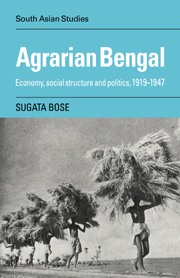Book contents
- Frontmatter
- Contents
- List of maps
- Preface
- List of abbreviations
- PART I AGRARIAN ECONOMY AND SOCIETY: STRUCTURE AND TRENDS
- 1 Introduction: A typology of agrarian social structure in early twentieth-century Bengal
- 2 Subsistence and the market I
- 3 Subsistence and the market II: The peasants' produce
- 4 The peasantry in debt: The working and rupture of systems of rural credit relations
- 5 Peasants into proletarians? The market in land and the question of change in the social organisation of production
- PART II PEASANTS AND POLITICS
- Conclusion
- Glossary
- Select bibliography
- Index
5 - Peasants into proletarians? The market in land and the question of change in the social organisation of production
from PART I - AGRARIAN ECONOMY AND SOCIETY: STRUCTURE AND TRENDS
Published online by Cambridge University Press: 24 October 2009
- Frontmatter
- Contents
- List of maps
- Preface
- List of abbreviations
- PART I AGRARIAN ECONOMY AND SOCIETY: STRUCTURE AND TRENDS
- 1 Introduction: A typology of agrarian social structure in early twentieth-century Bengal
- 2 Subsistence and the market I
- 3 Subsistence and the market II: The peasants' produce
- 4 The peasantry in debt: The working and rupture of systems of rural credit relations
- 5 Peasants into proletarians? The market in land and the question of change in the social organisation of production
- PART II PEASANTS AND POLITICS
- Conclusion
- Glossary
- Select bibliography
- Index
Summary
The issue of land transfers has been central to the debate about the extent to which the structure of South Asian agrarian society changed under colonial rule. There is the well-worn view that the imposition of a relatively inflexible revenue demand in cash led to a greater involvement in the market economy and a permanent cycle of indebtedness resulted in a process of proletarianisation of the peasantry through rapid land alienation. Morris D. Morris argues against this view, pointing out that its adherents cited evidence about land transfers mainly from periods of famine, which may not be representative. Another line of attack against the old view was launched by Dharma Kumar whose work on south India demonstrates that landlessness existed in pre-British times and did not increase significantly under colonial rule. C.J. Baker suggests a rather static picture in the patterns of land ownership over the last century of colonial rule in three regions of the Tamilnad countryside, marked by differences of economic ecology and in social structure. Recent work on eastern India has produced apparently contradictory viewpoints on the nature and extent of pauperisation of the peasantry. Rajat and Ratna Ray, proponents of an equilibrium model, conclude: ‘Such a development leading eventually to the complete disintegration of the self-employed peasantry on their own farms hardly seems to have ever been a serious possibility’.
- Type
- Chapter
- Information
- Agrarian BengalEconomy, Social Structure and Politics, 1919-1947, pp. 146 - 178Publisher: Cambridge University PressPrint publication year: 1987



